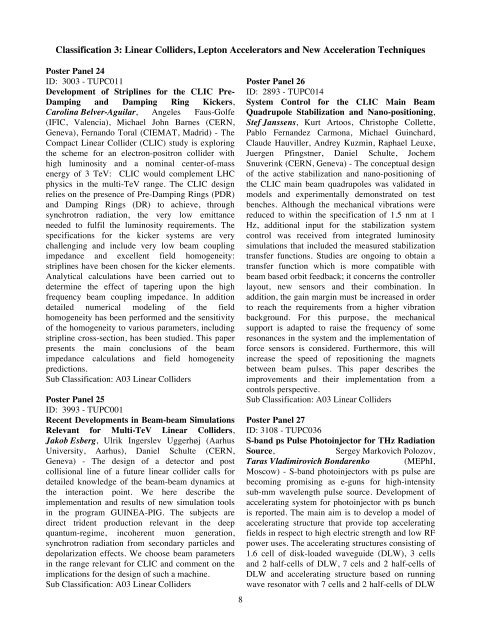Abstracts Brochure - 2nd International Particle Accelerator Conference
Abstracts Brochure - 2nd International Particle Accelerator Conference
Abstracts Brochure - 2nd International Particle Accelerator Conference
Create successful ePaper yourself
Turn your PDF publications into a flip-book with our unique Google optimized e-Paper software.
�<br />
Classification 3: Linear Colliders, Lepton <strong>Accelerator</strong>s and New Acceleration Techniques<br />
Poster Panel 24<br />
ID: 3003 - TUPC011<br />
Development of Striplines for the CLIC Pre-<br />
Damping and Damping Ring Kickers,<br />
Carolina Belver-Aguilar, Angeles Faus-Golfe<br />
(IFIC, Valencia), Michael John Barnes (CERN,<br />
Geneva), Fernando Toral (CIEMAT, Madrid) - The<br />
Compact Linear Collider (CLIC) study is exploring<br />
the scheme for an electron-positron collider with<br />
high luminosity and a nominal center-of-mass<br />
energy of 3 TeV: CLIC would complement LHC<br />
physics in the multi-TeV range. The CLIC design<br />
relies on the presence of Pre-Damping Rings (PDR)<br />
and Damping Rings (DR) to achieve, through<br />
synchrotron radiation, the very low emittance<br />
needed to fulfil the luminosity requirements. The<br />
specifications for the kicker systems are very<br />
challenging and include very low beam coupling<br />
impedance and excellent field homogeneity:<br />
striplines have been chosen for the kicker elements.<br />
Analytical calculations have been carried out to<br />
determine the effect of tapering upon the high<br />
frequency beam coupling impedance. In addition<br />
detailed numerical modeling of the field<br />
homogeneity has been performed and the sensitivity<br />
of the homogeneity to various parameters, including<br />
stripline cross-section, has been studied. This paper<br />
presents the main conclusions of the beam<br />
impedance calculations and field homogeneity<br />
predictions.<br />
Sub Classification: A03 Linear Colliders<br />
Poster Panel 25<br />
ID: 3993 - TUPC001<br />
Recent Developments in Beam-beam Simulations<br />
Relevant for Multi-TeV Linear Colliders,<br />
Jakob Esberg, Ulrik Ingerslev Uggerhøj (Aarhus<br />
University, Aarhus), Daniel Schulte (CERN,<br />
Geneva) - The design of a detector and post<br />
collisional line of a future linear collider calls for<br />
detailed knowledge of the beam-beam dynamics at<br />
the interaction point. We here describe the<br />
implementation and results of new simulation tools<br />
in the program GUINEA-PIG. The subjects are<br />
direct trident production relevant in the deep<br />
quantum-regime, incoherent muon generation,<br />
synchrotron radiation from secondary particles and<br />
depolarization effects. We choose beam parameters<br />
in the range relevant for CLIC and comment on the<br />
implications for the design of such a machine.<br />
Sub Classification: A03 Linear Colliders<br />
8<br />
Poster Panel 26<br />
ID: 2893 - TUPC014<br />
System Control for the CLIC Main Beam<br />
Quadrupole Stabilization and Nano-positioning,<br />
Stef Janssens, Kurt Artoos, Christophe Collette,<br />
Pablo Fernandez Carmona, Michael Guinchard,<br />
Claude Hauviller, Andrey Kuzmin, Raphael Leuxe,<br />
Juergen Pfingstner, Daniel Schulte, Jochem<br />
Snuverink (CERN, Geneva) - The conceptual design<br />
of the active stabilization and nano-positioning of<br />
the CLIC main beam quadrupoles was validated in<br />
models and experimentally demonstrated on test<br />
benches. Although the mechanical vibrations were<br />
reduced to within the specification of 1.5 nm at 1<br />
Hz, additional input for the stabilization system<br />
control was received from integrated luminosity<br />
simulations that included the measured stabilization<br />
transfer functions. Studies are ongoing to obtain a<br />
transfer function which is more compatible with<br />
beam based orbit feedback; it concerns the controller<br />
layout, new sensors and their combination. In<br />
addition, the gain margin must be increased in order<br />
to reach the requirements from a higher vibration<br />
background. For this purpose, the mechanical<br />
support is adapted to raise the frequency of some<br />
resonances in the system and the implementation of<br />
force sensors is considered. Furthermore, this will<br />
increase the speed of repositioning the magnets<br />
between beam pulses. This paper describes the<br />
improvements and their implementation from a<br />
controls perspective.<br />
Sub Classification: A03 Linear Colliders<br />
Poster Panel 27<br />
ID: 3108 - TUPC036<br />
S-band ps Pulse Photoinjector for THz Radiation<br />
Source, Sergey Markovich Polozov,<br />
Taras Vladimirovich Bondarenko (MEPhI,<br />
Moscow) - S-band photoinjectors with ps pulse are<br />
becoming promising as e-guns for high-intensity<br />
sub-mm wavelength pulse source. Development of<br />
accelerating system for photoinjector with ps bunch<br />
is reported. The main aim is to develop a model of<br />
accelerating structure that provide top accelerating<br />
fields in respect to high electric strength and low RF<br />
power uses. The accelerating structures consisting of<br />
1.6 cell of disk-loaded waveguide (DLW), 3 cells<br />
and 2 half-cells of DLW, 7 cels and 2 half-cells of<br />
DLW and accelerating structure based on running<br />
wave resonator with 7 cells and 2 half-cells of DLW


